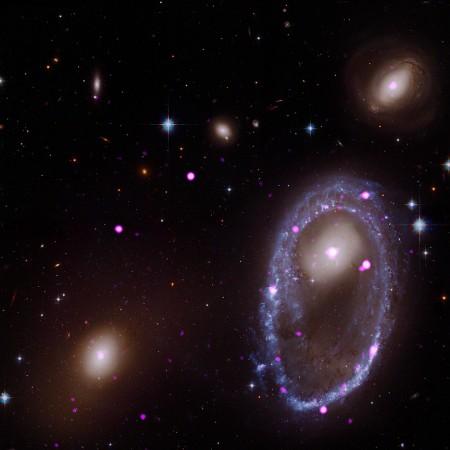
A massive ring of celestial bodies, either made of black holes or Neutron stars has been found by astronomers using NASA's Chandra X-ray Observatory. The ring was found in a galaxy that is about 300 million light years away.
The one ring does not really wield power over its nearby galaxies, but can be useful in understanding what happens when two of them crash into each other, says NASA in a release. The space trained two of their observatories at this galaxy far far away, called AM 0644-741 (AM 0644 for short).
The image above was created by combining Hubble optical data with Chandra's X-ray data. While the Hubble data shows a ring and colour composite in RGB, Chandra's image shows that there is a strong X-ray coming from the region. These could be binary systems powered by stellar-mass black holes or neutron stars, says NASA.
Arranged in a ring, this remarkable stationing is rather unusual.

As to whether this ring is made of either neutron stars or black holes come from, researchers think that it was gravity. This formation could have happened when one galaxy pulled another nearby one into itself, by the sheer force of gravity. The first galaxy—lower left of the image—notes the release, likely generated ripples in the gasses of the second one. AM 0644 is seen in the lower right. These ripples then met with the gasses that produced a ring of gas constantly expanding, triggering the birth of new stars.
When new stars are formed, the largest of them lead short lives, on a cosmic scale, that is about a few million years. As they die, they explode into supernovas leaving behind one of two things- black holes or neutron stars. Black holes continue to grow and gain masses and reach up to 20 times the solar mass, neutron stars stay about the same mass as the Sun.
At times, says NASA's release, some black holes or neutron stars might have close companion stars and siphon gas from them and gases flow in a circular pattern, like water flowing out of a drain pipe. This movement and friction as a result super-heats the gasses to a point where they begin to produce a massive amount of X-ray radiation that Chandra can easily detect.
Results of this study was reported in a new paper led by Anna Wolter from INAF-Osservatorio Astronomico di Brera in Milano, Italy.

















